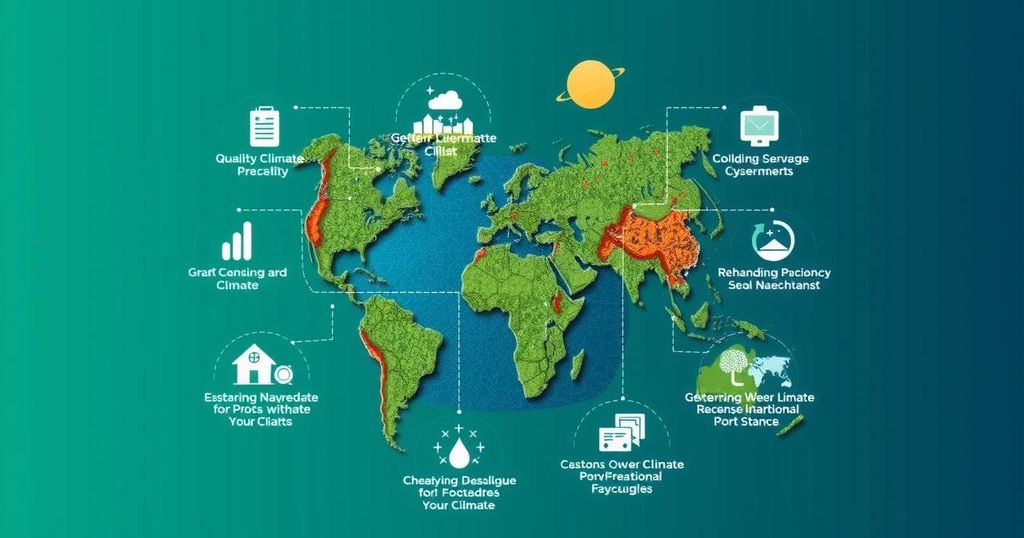The International Fund for Animal Welfare (IFAW) has released new guidelines to aid governments in integrating wildlife conservation into their Nationally Determined Contributions (NDCs) to enhance climate action. Launched during COP16 in Cali, Colombia, these guidelines provide ten actionable steps to emphasize wildlife’s role in carbon sequestration, encourage economic benefits, and address the omission of wildlife in current climate strategies. This initiative supports the convergence of climate resilience and biodiversity conservation as nations prepare their NDC updates for 2025.
On October 21, 2024, during the UN Convention on Biological Diversity’s 16th Conference of the Parties (COP16) in Cali, Colombia, the International Fund for Animal Welfare (IFAW) unveiled a set of guidelines aimed at aiding governments and policymakers in the integration of wildlife conservation within their Nationally Determined Contributions (NDCs) for climate action. This initiative comes at a crucial moment as nations prepare to revise their NDCs for compliance with the Paris Agreement by 2025, underscoring the importance of acknowledging wildlife’s key role in both carbon sequestration and climate resilience. The IFAW’s newly published document, entitled “Wildlife Guidelines for NDCs: Integrating Wildlife Conservation into National Climate Action Plans,” is described as a vital tool in the fight against global climate change, providing actionable steps that countries may implement. Simon Addison, IFAW’s Climate Advisor, emphasized the practical nature of the guidelines, stating that they present a straightforward roadmap for harnessing wildlife conservation’s potential to mitigate climate change and bolster climate resilience. Ample evidence suggests that current climate strategies frequently neglect to consider the impact of wildlife conservation, particularly in regions abundant in biodiversity yet vulnerable to climate change. According to Addison, the omission of wildlife in greenhouse gas inventories represents a significant opportunity loss in enhancing climate resilience and protecting biodiversity. The guidelines aim to reposition wildlife conservation from being merely an environmental concern to a fundamental component of climate strategy, thus facilitating a dual benefit of climate action and biodiversity preservation. Key elements of the guidelines include: – Critical Role of Wildlife: Recognizing that keystone species, such as elephants and large predators, contribute substantially to ecosystems that sequester carbon. Protecting and managing these species is essential for promoting carbon capture and maintaining ecosystem health. – Framework for Integration: The ten-step strategy outlines a structured approach for countries, guiding them in identifying priority species, incorporating wildlife into national greenhouse gas inventories, and aligning wildlife conservation efforts with broader policy goals. – Economic Incentives: The guidelines also illustrate how wildlife protection and restoration can yield economic advantages, particularly for biodiversity-rich Least Developed Countries. The economic viability linked with maintaining wildlife populations can bolster climate-resilient development and offer sustainable livelihoods, while also facilitating access to new carbon finance opportunities. The comprehensive guidelines are publicly accessible for download at https://www.ifaw.org/resources/wildlife-guidelines-for-ndcs.
The guidelines presented by the International Fund for Animal Welfare (IFAW) highlight a critical intersection between wildlife conservation and climate action. While nations are updating their Nationally Determined Contributions (NDCs) under the Paris Agreement, it is essential to integrate wildlife conservation as a significant aspect of climate strategies. This integration is vital for supporting carbon sequestration capabilities and enhancing the resilience of ecosystems that face the threatening impacts of climate change. The recognition of wildlife’s importance in climate plans serves to advance both ecological health and climate action.
In conclusion, the introduction of guidelines by the IFAW at COP16 marks a pivotal advancement in aligning wildlife conservation with climate action plans. By integrating wildlife conservation into NDCs, nations can restore not only ecosystems but also bolster their efforts in combating climate change while securing sustainable economic benefits for vulnerable communities. These actionable steps present a proactive framework for countries to elevate wildlife conservation to a fundamental element of their climate strategies, ultimately advocating for a holistic approach to addressing the dual crises of climate change and biodiversity loss.
Original Source: www.ifaw.org






